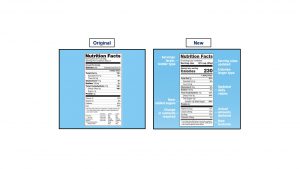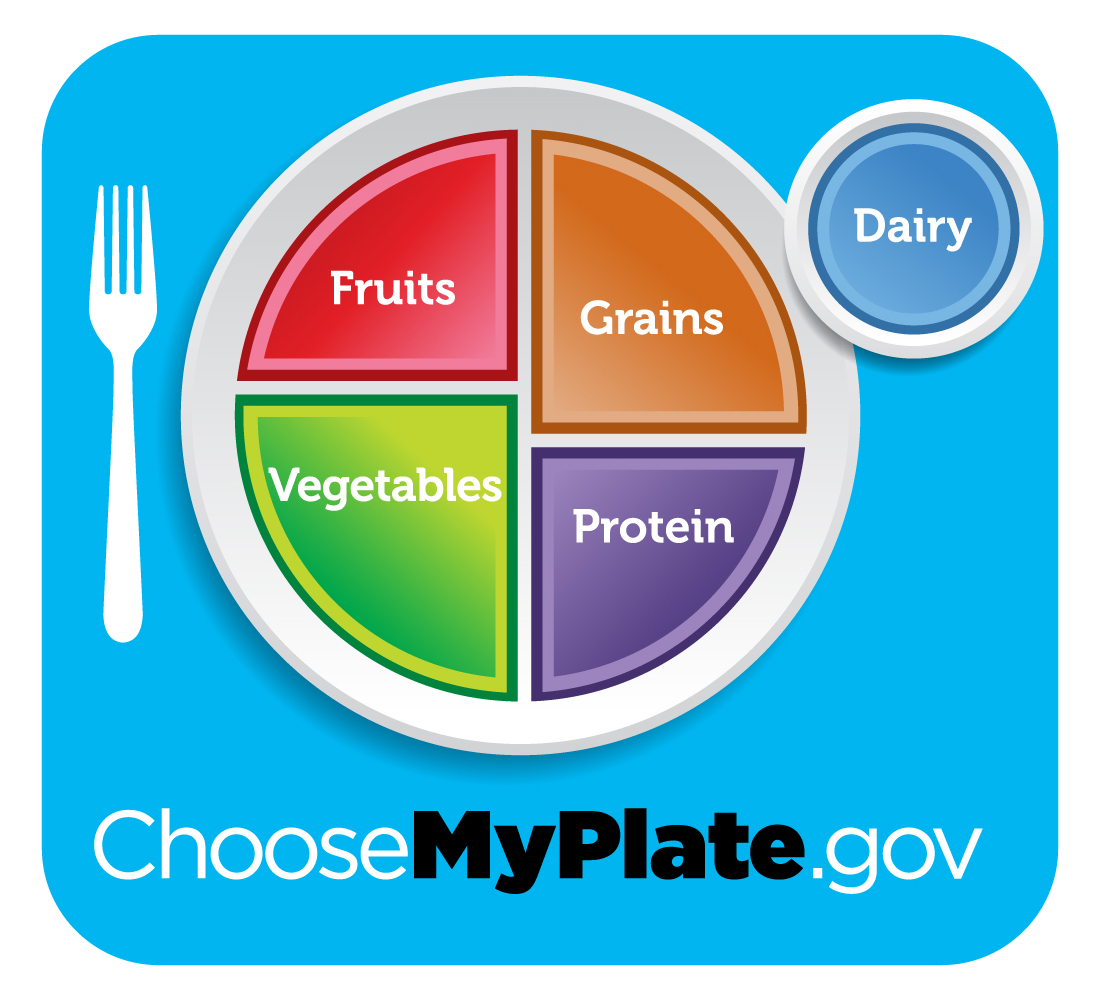
by Laurie Osgood | Jul 17, 2016
![Pam-150x150[1]](https://nwdistrict.ifas.ufl.edu/fcs/files/2016/07/Pam-150x1501.jpg) On May 20, 2016, the U.S. Food and Drug Administration released the new Nutrition Facts label requirements for packaged foods. The new version represents the latest in food science research and is designed to make it easier for consumers to get the information they need to make healthy choices. These changes are the first updates to nutrition labels in about 20 years.
On May 20, 2016, the U.S. Food and Drug Administration released the new Nutrition Facts label requirements for packaged foods. The new version represents the latest in food science research and is designed to make it easier for consumers to get the information they need to make healthy choices. These changes are the first updates to nutrition labels in about 20 years.
Larger food manufacturers will be given two years to comply with these new labeling requirements. Smaller manufacturers with sales of less than $10 million will be given an additional year to update the food labels on their products.
What’s New?
Although the Nutrition Facts label will look very similar, the re-designed label will contain several important changes, including slightly larger, bolder type and information consumers need to make better food choices when planning and buying food for their families.
There are five key changes to the Nutrition Facts label that appears on products such as breads, canned and frozen foods, cereals, snacks, desserts, and drinks. These changes appear in the Serving Size & Calories, % Daily Values, Added Sugars, Nutrients, and Footnote sections of the Nutrition Facts label.
The New Label Format: Original vs. New

5 Key Changes to the Nutrition Facts Label:
- Larger Font for Serving Size & Calories: The serving size and calorie count that appears on the new label is much larger, making it easier for people to read and identify how many calories they are about to consume. Serving sizes now will be based on what people actually eat, rather than on what the food manufacturer suggests we eat.
- Daily Values: The Daily Values for Sodium, Dietary fiber, and vitamin D will be updated on the Nutrition Facts label. In addition to their Daily Values, the actual amounts of these nutrients are now required. The percent Daily Values (% DV) make it easy for consumers to compare the nutrient content of one product or brand to a similar product.
- Added Sugars: The new label displays Added Sugars in grams as well as %DV to help people monitor their calorie intake. The Dietary Guidelines for Americans 2015-2020 recommends reducing added sugar consumption to less than 10% of calories per day.
- Vitamin D and Potassium: Vitamin D and Potassium are being added to the food label because they are important micronutrients that Americans do not consume enough of. Vitamin D plays a vital role in bone health and potassium can help lower blood pressure. Vitamins A and C will no longer be required because deficiencies of those vitamins are rare.
- Footnote: The footnote contains a standard statement which tells consumers how much a nutrient in a serving of food contributes to a daily 2,000-calorie diet.
Want more Information?
The Family and Consumer Sciences (FCS) Agent at your County UF/IFAS Extension office may have more information on food labeling. For more information, please visit our website at http://sfyl.ifas.ufl.edu/map/index.shtml
References:
U.S. Food and Drug Administration. (2016). Changes to the Nutrition Facts Label. http://www.fda.gov/Food/GuidanceRegulation/GuidanceDocumentsRegulatoryInformation/LabelingNutrition/ucm385663.html
U.S. Food and Drug Administration. (2016). FDA Modernizes Nutrition Facts Label for Packaged Foods. http://www.fda.gov/NewsEvents/Newsroom/PressAnnouncements/ucm502182.html

by sbouie | Jul 17, 2016
 Picnics are a great opportunity for families to enjoy the great outdoors. It provides time to experience special bonding while enjoying the fresh air and delicious food. However, we should always be cautious of food borne illness.
Picnics are a great opportunity for families to enjoy the great outdoors. It provides time to experience special bonding while enjoying the fresh air and delicious food. However, we should always be cautious of food borne illness.
Let’s keep food and your family safe from the start! Whether the foods are from home, a store, or restaurant, follow the simple rules of keeping hot foods hot and cold foods cold. Remember that bacteria can grow fast at temperatures between 40°F and 140°F – the Danger Zone. Eat and promptly chill leftovers within two hours, and if the outside air temperature is above 90°F, do so within one hour.
If you plan to cook on site, make sure raw meats are packed well and are separated from ready-to-eat foods to prevent any cross-contamination. All perishable foods must be kept cold (40°F or below) in insulated boxes with enough ice, frozen gel packs, or other cold source, such as a container of frozen water. If possible, bring an appliance thermometer along to monitor the box temperature. When you grill the meat, make sure it is cooked to the right temperature. Also, bring enough potable water if none will be available at the site, and pack clean, wet, disposable cloths or moist towelettes and paper towels for cleaning hands and surfaces. Keep your tailgate party fun and bacteria-free for your family’s well-being!
Besides the food, plan your time. Plan some fun outdoor games that the entire family will enjoy. You may even plan a nature walk, name the cloud’s shape, or be creative and create your own activity. Whatever you plan, always involve the entire family. Every family member should be included.
This is the best time to say “no electronic devices.” This is time for the family to have face time without interruptions – time to talk to each other and grow closer. Picnic time translates “it’s family time” – eating outside in the fresh air and enjoying your family.
Reference: Food Safety and Tailgating, Amy Simonne. EDIS Publication #FAR8712

by Heidi Copeland | Jun 29, 2016
 July is National Blueberry Month and what a great testament it is to be named fruit of the month during this patriotic season! Blueberries are one of the few fruits native to North America and have been enjoyed for centuries, both wild and cultivated. In fact, the United States is the world’s largest producer of blueberries. Although Florida has hundreds of small blueberry farms across the state, Michigan still leads the pack in national blueberry production.
July is National Blueberry Month and what a great testament it is to be named fruit of the month during this patriotic season! Blueberries are one of the few fruits native to North America and have been enjoyed for centuries, both wild and cultivated. In fact, the United States is the world’s largest producer of blueberries. Although Florida has hundreds of small blueberry farms across the state, Michigan still leads the pack in national blueberry production.
Nonetheless, blueberries are an important agricultural crop as well as a nutritional powerhouse. Blueberries are the fruits of a shrub, they grow in clusters, and range in size from that of a small pea to a marble. Blueberries are deep in color, ranging from blue to purple-black, and feature a white-gray waxy “bloom” that covers the berry’s surface and serves as a protective coat. The skin surrounds a semi-transparent flesh that covers tiny seeds.
Blueberries are low in calories (84 per cup), high in fiber (4 grams per cup), and full of antioxidants, vitamins, and minerals. Additionally, blueberries taste delicious, producing flavors that range from mildly sweet (cultivated) to tart and tangy (wild).
When purchasing (or picking), choose blueberries that are firm and have a uniform color. Avoid berries that appear dull in color or are soft and watery in texture.
Before refrigerating blueberries, remove any damaged or moldy berries to prevent the rest from spoiling. Don’t wash berries until right before eating, as washing introduces moisture, which speeds up the decaying process.
If you plan to freeze your blueberries, don’t wash before freezing, as washing can make their skins tough. Instead, simply pack your blueberries into a freezable container, seal, and freeze.
An alternative way to freeze blueberries that may make the fruit easier to remove from the container is to simply spread a single layer of prepared berries on shallow trays and freeze (lining the pan with a piece of parchment paper works well here, too). When frozen, strike the tray on a counter, then promptly and properly package, label, and return the blueberries to the freezer. The fruit pieces will not stick together, and small quantities of blueberries can be removed easily for use, but be sure to wash the thawed berries prior to use.
Most frozen fruits maintain high quality for eight to twelve months at 0°F or below. Unsweetened fruits lose quality faster than those packed in sugar or syrup. Longer storage will not make the food unfit for use, but may impair its quality. As with all frozen foods, it is a good idea to use the FIFO method (First In, First Out) when taking out of the freezer.
Blueberries are not just for pie anymore. Branch out a bit. The Florida Blueberry Growers Association has a database of recipes for drinks, breakfast foods, breads, appetizers, salads, dressings, sauces, entrée items, and desserts.
Just like summer… blueberries are full of endless possibilities. Try some today!
Check out these other Fresh from Florida items in season in July: http://www.freshfromflorida.com/content/download/16798/269945/07July.pdf
BLUEBERRY SALSA
Ingredients:
- 2 cups fresh blueberries
- 1 cup finely diced fresh Florida mango
- 1 cup finely diced fresh Florida cantaloupe
- 1 cup finely diced fresh Florida watermelon
- 1 jalapeno pepper, seeds and membrane removed, minced
- 2 to 3 tablespoons lime or lemon juice, divided
- 1/2 teaspoon lime zest
- 3 tablespoons chopped cilantro
- 1 garlic clove minced
- 1/4 cup diced red onion
- Salt as needed
Directions:
- Combine the fruit, jalapeño, 2 tablespoons of the lime juice, lemon or lime zest, cilantro and red onion.
- Season with salt and additional lemon or lime juice as needed.
- Serve with tortilla chips or as an accompaniment to fish or chicken.

by Amy Mullins, PhD, RDN | Jun 29, 2016
I t seems that most Americans start their mornings off with a mug of hot coffee, iced coffee, or any number of fancy variations. For many, it’s the key to starting your day off right. Ever notice what happens when you don’t get your coffee in the morning? Let’s just say, it can be enough to change your mood for the worse. So, what is it about coffee that is so appealing to people worldwide? You guessed it… caffeine.
t seems that most Americans start their mornings off with a mug of hot coffee, iced coffee, or any number of fancy variations. For many, it’s the key to starting your day off right. Ever notice what happens when you don’t get your coffee in the morning? Let’s just say, it can be enough to change your mood for the worse. So, what is it about coffee that is so appealing to people worldwide? You guessed it… caffeine.
Caffeine acts in the body as a short-acting stimulant and is found naturally in certain plants, seeds, and the fruits of more than 60 plants such as tea, coffee, cocoa beans, and kola nuts. Caffeine also is widely added to a growing number and variety of beverages, edibles, and medications.
There have been numerous studies on caffeine and how it affects the body – some good, some bad, and some inconclusive. The National Institutes of Health (NIH) states that for most people, the amount of caffeine in two to four cups of coffee a day is not harmful. Some people may be more sensitive to the effects of caffeine and may even experience harmful effects (including pregnant and nursing women, children and teenagers) and should limit or avoid its use.
It is generally recognized that up to 400 mg of caffeine per day is considered safe for healthy adults; however, too much caffeine (500-600 mg/day) can cause problems such as:
- Make you jittery, shaky, nervous, restless, and irritable
- Make it hard to fall asleep or stay asleep
- Headaches or dizziness
- Make your heart beat faster or cause abnormal heart rhythms
- Dehydration
- Upset stomach
- Make you dependent on it so you need to take more of it. If you stop using caffeine, you could get withdrawal symptoms.
- Interfere with the metabolism of certain medications.
How much caffeine is in your favorite coffee, tea, soft drink, snack food, chocolate, or medication? A regular home-brewed cup of coffee (8 oz.) typically has about 100mg of caffeine. But, different brands and products contain widely varying amounts. For instance, a grande cup of Starbucks coffee has 330 mg compared to McDonald’s brewed coffee with only 133 mg of caffeine, for approximately the same size.
Want a real “eye-opener”? Check out this extensive list of the Caffeine Content of Food & Drugs by the Center for Science in the Public Interest.
The bottom line is that it’s okay to drink your cup of Joe in the morning and/or afternoon, but just remember moderation is the key!
References:
https://www.nlm.nih.gov/medlineplus/
http://www.eatright.org/
http://www.cspinet.org/

by Angela Hinkle | Jun 29, 2016
What’s the best way to enjoy a variety of the nutrients and other substances needed for good health? Eat from every food group every day.
Foods are put into food groups because they provide key nutrients, in about the same amounts. For example, the milk, yogurt, and cheese in the Dairy Group provide about the same amount of the nutrient, calcium. You don’t have to eat from every food group at every meal. However, to get all the nutrients you need for good health, it’s best to eat a variety from each of the five food groups throughout the whole day.
To get that variety, choose different foods within each food group. Oranges are a great source of Vitamin C, but if the only fruit you ever eat is oranges, you’re probably missing out on lots of nutrients in all of those other yummy fruits.![myplate_blue[1]](https://nwdistrict.ifas.ufl.edu/fcs/files/2015/10/myplate_blue1-300x273.jpg)
Fruits like blueberries, apples, and watermelon are high in the nutrients vitamin C, folate, and fiber, which help to maintain the health of your body and decrease some chronic diseases.
Vegetables like kale, squash, and onions offer potassium, fiber, and vitamin A, which can help to maintain healthy blood pressure, lower risk of heart disease, and keep eyes and skin healthy.
Grain Foods, especially the “whole grain” variety like oatmeal, whole wheat bread, and brown rice, are great sources of several B vitamins and minerals – like iron. These and other nutrients in the grains group help the body to release energy, aid in digestion, and form red blood cells.
Dairy foods, like milk, yogurt, and cheese, are excellent sources of calcium, which is important for building and maintaining strong, healthy bones.
Protein foods, including lean meats and poultry, fish, nuts and seeds, eggs, and tofu, provide the protein needed to build, maintain, and repair tissues in our body. Muscles and organs, like your heart, are made of protein.
You don’t have to and probably shouldn’t eat the exact same thing every day. You should, however, Eat Every Food Group Every Day. It’s a brand new day, go ahead…get started…right now!
For more information on ways to get variety in all the food groups, check out this site from the United Sates Department of Agriculture (USDA): http://www.choosemyplate.gov/MyPlate

by Dorothy C. Lee | Jun 29, 2016
 A busy schedule is the most used excuse for not eating nutritiously. When pressed for time, it’s easy to fall into the habit of making unhealthy food choices.
A busy schedule is the most used excuse for not eating nutritiously. When pressed for time, it’s easy to fall into the habit of making unhealthy food choices.
For those who have no time to prepare meals during the work day, yet want to eat nutritiously, one solution is to plan ahead and prepare mini meals and snacks that can be eaten at any time. Not only will this save money, it will help guard against that temptation of vending machines or fast food. Several snacks spaced throughout the day can take the place of several meals. Snacks also help curb between-meal hunger. Snacking is a great solution as long as you don’t forget to make healthy choices.
Here are some tips for preparing nutritious on-the-go meals and snacks:
Planning Ahead
- Your food choices will depend partly on the facilities available where you work. If there is a refrigerator, food selection can be more varied and a microwave is a plus.
- Plan a week’s worth of snacks. Add these food items to your weekly shopping list.
- Invent ways to use leftovers in snacks. Be creative!
- Prepare and pack the food the night before if your mornings are hectic.
- Create a mess kit to keep at your desk. Include a can opener, mug, plate, utensils, and napkins. Paper plates and plastic utensils make clean-up easy.
Pack It Up at Home
- Invest in a selection of small plastic containers that can be easily packed into an insulated lunch bag. These are usually inexpensive.
- Use insulated containers to keep hot foods hot and cold foods cold.
- Purchase a selection of plastic bags with a variety of seals. Also, have aluminum foil and plastic wrap available.
Snacking by Food Group
- Meat, Poultry, Fish and Alternatives – Try individual-sized cans of fish and chicken; hard cooked eggs; peanut butter; unsalted nuts; cooked, dried peas and beans in salads; and leftover cooked meats and poultry in sandwiches and salads.
- Dairy – Include low fat-yogurt and yogurt drinks in convenient serving size containers, low-fat cottage cheese, skim milk, low- fat milk, and individually wrapped cheeses. You can satisfy a sweet craving with individual servings of ready-made pudding or a flavored cheese.
- Grains – For convenience, include individual serving size boxes of cereal. Choose cereals low in sugar. Select enriched whole grain breads, rolls, crackers, and pita bread. Whole grain or enriched cookies or muffins are a nutritious choice for something sweet.
- Fruits/Vegetables – Fruits are a natural to pack since many come in their own package – for instance, bananas, grapes, oranges, apples and pears. Dried fruits now are available in serving size packets. You also can buy them in bulk and make your own packets.
- Vegetables – Fresh vegetables make great crunchy snacks. Serve with a yogurt- or cottage cheese-based dip, or tossed with a vinaigrette as a vegetable salad.
- Munchies/Combos – Mix plain yogurt with fresh fruits or dry whole grain cereal.
- Trail mix in individual serving size packets travels well. Make your own with dried fruits, unsalted nuts, seeds, and cereals.
- Stuff celery with peanut butter or farmer cheese mixed with raisins.
- Mix salads with cottage cheese and chopped fresh fruits or vegetables.
- Try individual serving size packets of whole grain chips, potato chips, and pretzels.
- Snacks You Can Keep in Your Desk Drawer – Keep a supply of emergency rations such as peanut butter, whole grain crackers, nuts, dark chocolate, and raisins available for days when you forget lunch and just cannot get out.
Munching on this combination during the day may help you resist turning in at the first fast food place you pass on the way home!

![Pam-150x150[1]](https://nwdistrict.ifas.ufl.edu/fcs/files/2016/07/Pam-150x1501.jpg) On May 20, 2016, the U.S. Food and Drug Administration released the new Nutrition Facts label requirements for packaged foods. The new version represents the latest in food science research and is designed to make it easier for consumers to get the information they need to make healthy choices. These changes are the first updates to nutrition labels in about 20 years.
On May 20, 2016, the U.S. Food and Drug Administration released the new Nutrition Facts label requirements for packaged foods. The new version represents the latest in food science research and is designed to make it easier for consumers to get the information they need to make healthy choices. These changes are the first updates to nutrition labels in about 20 years.








![myplate_blue[1]](https://nwdistrict.ifas.ufl.edu/fcs/files/2015/10/myplate_blue1-300x273.jpg)

